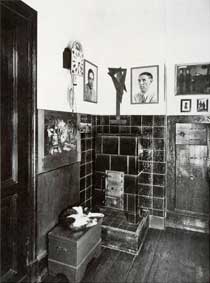August Sander was born in 1876 in Herdorf, in the country outside of Cologne, Germany, the son of a mining carpenter. He was one of eight children. As a teenager he worked at a local iron ore mine. There he became acquainted with a professional photographer who aroused his interest in the medium. After military service and apprenticeship in Trier, he travelled Germany, visiting and working at photographic studios en route. Sander then found employment at the Photographische Kunstanstalt Greif, a studio in Linz, Austria, which he took over in 1902. The technical standard of his photographs was state-of-the-art. During the Linz years, he married Anna (1902) and celebrated the birth of his sons Erich (1903) and Gunther (1907). In 1910 the young family moved to Cologne. Twins Sigrid and Helmut were born in 1911; only daughter Sigrid survived. Sander established a studio in the Lindenthal district of Cologne and embarked on the photographic work in the Westerwald that yielded important material for his later opus, People of the 20th Century. From 1920 onwards Sander engaged in intensive exchange with the Cologne-based Progressive Group, especially with the painters Franz Wilhelm Seiwert and Heinrich Hoerle. The idea and concept for his great portraiture work People of the 20th Century started to take shape. In 1927, he staged his first presentation of the project at the Cologne Kunstverein. In 1929 a volume of photographs, titled Antlitz der Zeit [Face of the time], was published as a preview of the final work. The late 1920s and early 1930s were the height of Sander's career. In 1934 Sander's son Erich was denounced and sentenced to ten years imprisonment and Antlitz der Zeit was banned by the Nazis and the printing plates destroyed. Gradually, from 1942 onwards, the Sanders transferred their home to the Westerwald village of Kuchhausen where Sander spent the rest of his life. Sander managed to save a major part of his archive and moved it to his new home. The rediscovery of Sander's work began at the exhibiton Photokina (1951) in Germany, which was visited by Edward Steichen, then director of the photography department of the Museum of Modern Art, New York. Sander's participation in the travelling exhibition The Family of Man (1955), curated by Steichen, ensured the continuance of his legacy. August Sander died in Cologne in 1964 after a stroke. | | 
August Sander August Sander's studio/home, Cologne: workroom c.1930-42. J Paul Getty Museum, Los Angeles. © Die Photographische Sammlung/SK Stiftung KulturяAugust Sander Archiv, Cologne. Licensed by Viscopy, Australia
|